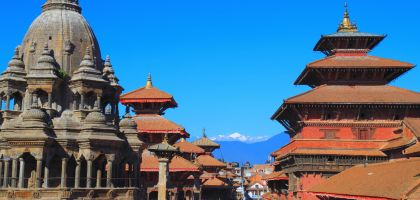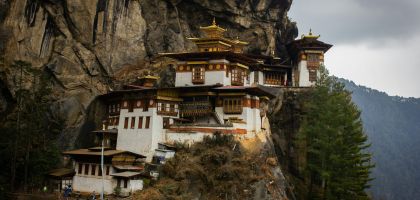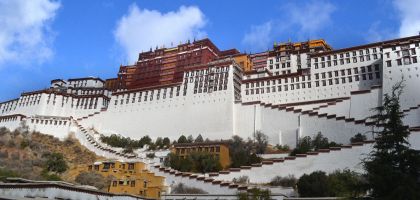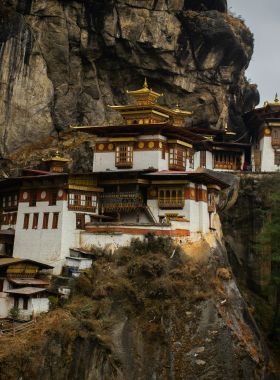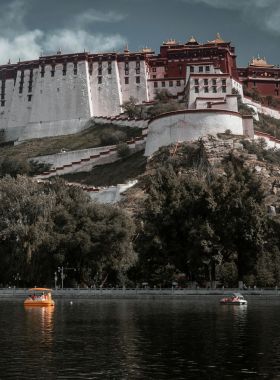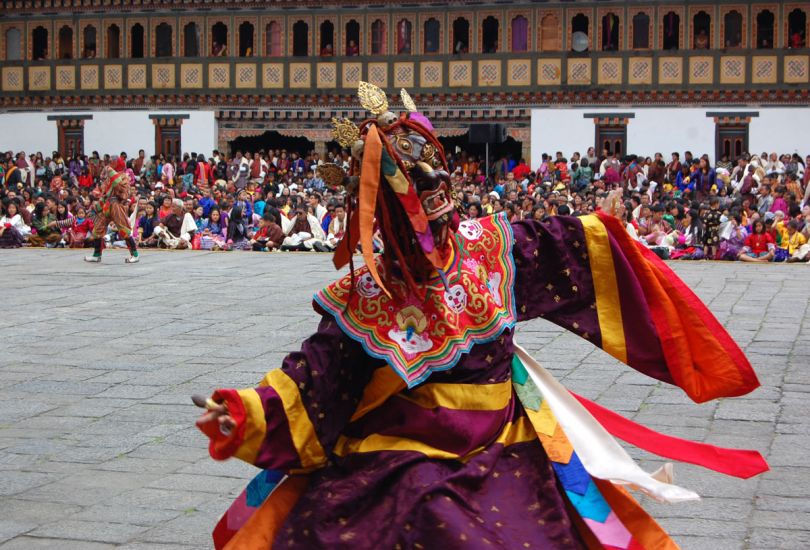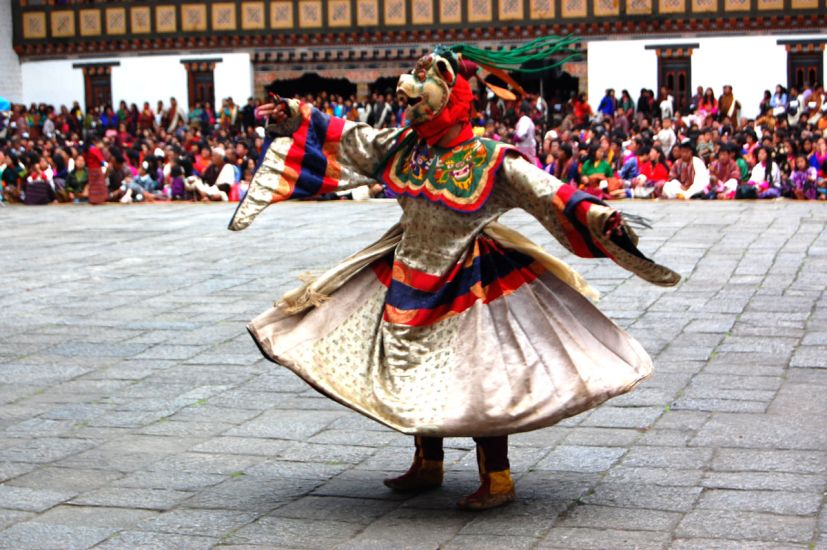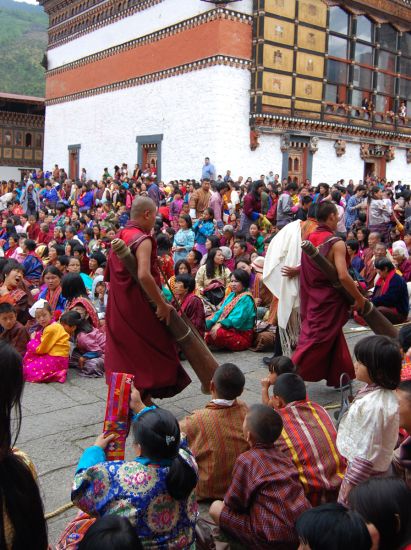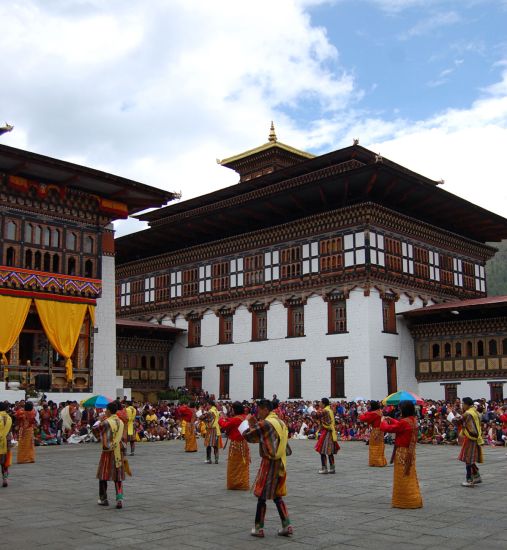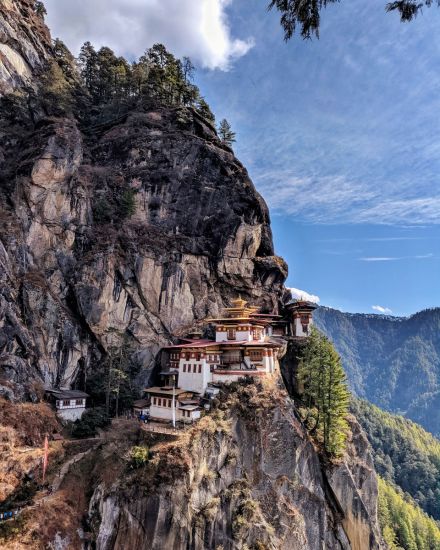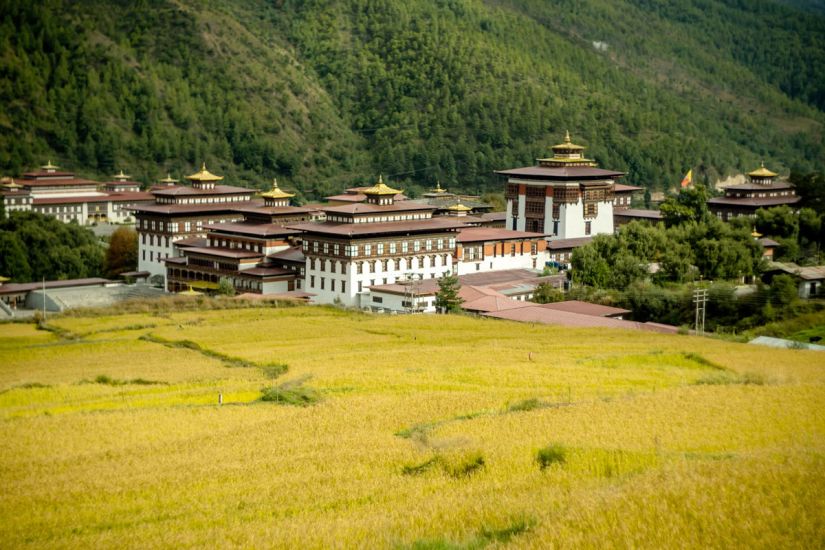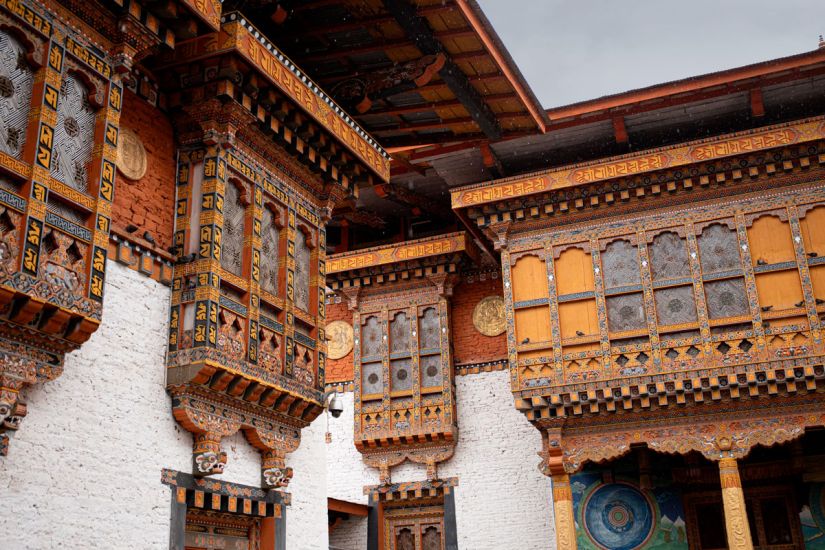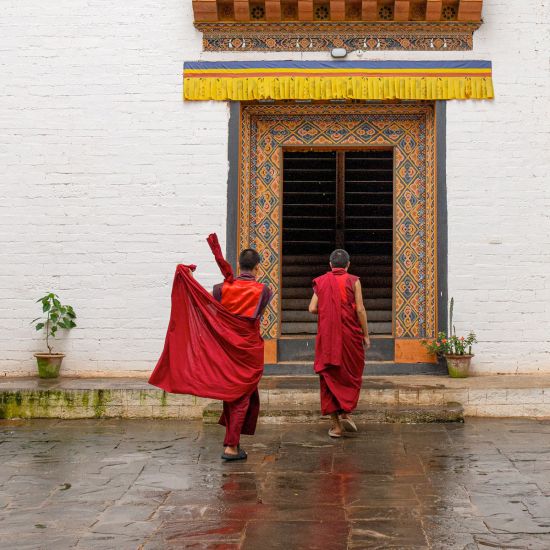Paro Festival Tour
11 Days / Bhutan
Activity
Difficulty Level
Destinations
Trip Start / End
Max Altitude
Accommodation
Travel Style
Best time to travel
Personalized Travel Advice

Dev Raj Nepal
+977 9851096523
Personalized Travel Advice

Dev Raj Nepal
+977 9851096523
Detailed Itinerary
01
DAY
01
The flight to Paro offers a breathtaking aerial view of the Himalayan mountain range. Upon arrival, you’ll be greeted by your guide and transferred to your hotel. Spend the evening relaxing and getting your first glimpse of Bhutan’s scenic beauty and peaceful atmosphere.
Flight to Paro
The flight to Paro offers a breathtaking aerial view of the Himalayan mountain range. Upon arrival, you’ll be greeted by your guide and transferred to your hotel. Spend the evening relaxing and getting your first glimpse of Bhutan’s scenic beauty and peaceful atmosphere.
02
DAY
02
Today, take part in one of Bhutan’s most treasured spiritual events, the Paro Tshechu. Set against the backdrop of the impressive Paro Dzong, the festival brings together monks, villagers and visitors for several days of sacred dance and deep cultural expression.
Monks dressed in ornate silk costumes and intricate masks perform Cham dances that depict ancient stories of deities, protectors and moral teachings. Every movement carries meaning, and the atmosphere is filled with the rhythmic sounds of horns, drums and chanting. Incense fills the air as the crowd watches in quiet reverence or joyful celebration.
All around, families gather to share traditional food, children play along the temple walls, and locals greet old friends. This is more than a performance. It’s a glimpse into Bhutan’s soul, a moment where community, culture and spirituality come together.
As part of your Paro Festival Tour, this experience offers rare insight into Bhutanese Buddhist traditions and the unity of its people. After the festivities, return to your hotel and enjoy a quiet evening in Paro, taking in the calm after a day filled with color and meaning.
Attend Paro Tshechu
Today, take part in one of Bhutan’s most treasured spiritual events, the Paro Tshechu. Set against the backdrop of the impressive Paro Dzong, the festival brings together monks, villagers and visitors for several days of sacred dance and deep cultural expression.
Monks dressed in ornate silk costumes and intricate masks perform Cham dances that depict ancient stories of deities, protectors and moral teachings. Every movement carries meaning, and the atmosphere is filled with the rhythmic sounds of horns, drums and chanting. Incense fills the air as the crowd watches in quiet reverence or joyful celebration.
All around, families gather to share traditional food, children play along the temple walls, and locals greet old friends. This is more than a performance. It’s a glimpse into Bhutan’s soul, a moment where community, culture and spirituality come together.
As part of your Paro Festival Tour, this experience offers rare insight into Bhutanese Buddhist traditions and the unity of its people. After the festivities, return to your hotel and enjoy a quiet evening in Paro, taking in the calm after a day filled with color and meaning.
03
DAY
03
Your journey this day, takes you on a memorable pilgrimage to Taktsang Monastery, famously known as the Tiger’s Nest. Clinging dramatically to a sheer rock face 900 meters above the Paro Valley, this iconic landmark is one of the most spiritually significant sites in Bhutan.
The hike begins through pine forests dotted with prayer flags and small shrines. The trail gradually ascends, offering sweeping views of the valley below and glimpses of the monastery from afar. Along the way, take time to pause at traditional rest stops or the quaint teahouse halfway up, where you can enjoy refreshments and take in the scenery.
The climb takes around 4 to 5 hours round-trip, depending on your pace. As you approach Taktsang, the final steps bring you to a place of profound peace and spiritual energy. According to legend, Guru Rinpoche flew to this site on the back of a tigress to meditate, making it one of the holiest temples in the Himalayas.
Inside the monastery, experience the stillness of sacred chambers, flickering butter lamps and the deep hum of prayers. The views from the cliff are nothing short of awe-inspiring, with mountain ridges and pine forests stretching into the distance.
After exploring the monastery and soaking in its tranquil atmosphere, descend slowly back to the valley. Return to your hotel in Paro for a well-earned evening of rest and reflection.
Hike to Taktsang Monastery
Your journey this day, takes you on a memorable pilgrimage to Taktsang Monastery, famously known as the Tiger’s Nest. Clinging dramatically to a sheer rock face 900 meters above the Paro Valley, this iconic landmark is one of the most spiritually significant sites in Bhutan.
The hike begins through pine forests dotted with prayer flags and small shrines. The trail gradually ascends, offering sweeping views of the valley below and glimpses of the monastery from afar. Along the way, take time to pause at traditional rest stops or the quaint teahouse halfway up, where you can enjoy refreshments and take in the scenery.
The climb takes around 4 to 5 hours round-trip, depending on your pace. As you approach Taktsang, the final steps bring you to a place of profound peace and spiritual energy. According to legend, Guru Rinpoche flew to this site on the back of a tigress to meditate, making it one of the holiest temples in the Himalayas.
Inside the monastery, experience the stillness of sacred chambers, flickering butter lamps and the deep hum of prayers. The views from the cliff are nothing short of awe-inspiring, with mountain ridges and pine forests stretching into the distance.
After exploring the monastery and soaking in its tranquil atmosphere, descend slowly back to the valley. Return to your hotel in Paro for a well-earned evening of rest and reflection.
04
DAY
04
Following breakfast, take a 1.5 hr drive to Thimphu, the capital of Bhutan. Enjoy this scenic drive through terraced rice fields and lush forests. In Thimphu, visit Tashichho Dzong, Bhutan’s most impressive building. It has traditionally been the seat of the Druk desi or ‘Dharma Raja’, the head of Bhutan’s civil government, an office that has been combined with the kingship since the creation of the monarchy in 1907. It houses the throne room of His Majesty the King of Bhutan and is the summer residence of the venerated monastic community. The current Dzong is the impressive result of redesigning the original medieval structure sanctioned by the Third King, His Majesty King Jigme Dorji Wangchuck when he moved the capital to Thimphu from Punakha. Overnight at a hotel in Thimphu.
Drive to Thimphu
Following breakfast, take a 1.5 hr drive to Thimphu, the capital of Bhutan. Enjoy this scenic drive through terraced rice fields and lush forests. In Thimphu, visit Tashichho Dzong, Bhutan’s most impressive building. It has traditionally been the seat of the Druk desi or ‘Dharma Raja’, the head of Bhutan’s civil government, an office that has been combined with the kingship since the creation of the monarchy in 1907. It houses the throne room of His Majesty the King of Bhutan and is the summer residence of the venerated monastic community. The current Dzong is the impressive result of redesigning the original medieval structure sanctioned by the Third King, His Majesty King Jigme Dorji Wangchuck when he moved the capital to Thimphu from Punakha. Overnight at a hotel in Thimphu.
05
DAY
05
Start your day with a visit to the Memorial Chorten, also known as the Thimphu Chorten. This large Tibetan-style Buddhist monument, adorned with golden spires and bells, was constructed in 1974 to honor the memory of the third King, Jigme Dorji Wangchuck.
Next, make a visit to the Folk Heritage Museum, housed in a traditional three-storied building. Established in 2001, this museum offers insights into the material culture and daily life of rural Bhutanese communities through a variety of artifacts.
Continue your journey at the National Institute of Zorig Chusum and the National Library of Bhutan, which was founded in 1967 under the patronage of HM Queen Ashi Phuntso Choden. The library began with a small collection of valuable texts. Discover the art of handmade paper production at the Junghi Paper Factory, where traditional papers made from plants are utilized for religious texts, packing materials, bags, lampshades, envelopes, and calendars.
Thereafter, visit the National Institute of Traditional Medicine, dedicated to integrating allopathic and traditional healing practices. This facility includes a large laboratory and production area that ensures the quality of medicinal components, including plants, minerals, and precious metals. They also cultivate various herbs and plants on-site for their Bhutanese medicines.
Finally, stop by the Bhutan Postal Museum, established in November 2015 to commemorate the 60th Birth Anniversary of His Majesty the Fourth Druk Gyalpo Jigme Singye Wangchuck. This museum narrates the story of Bhutan’s progress and development through the evolution of its communications and postal systems. Spend the night at your hotel in Thimphu.
Thimphu Exploration
Start your day with a visit to the Memorial Chorten, also known as the Thimphu Chorten. This large Tibetan-style Buddhist monument, adorned with golden spires and bells, was constructed in 1974 to honor the memory of the third King, Jigme Dorji Wangchuck.
Next, make a visit to the Folk Heritage Museum, housed in a traditional three-storied building. Established in 2001, this museum offers insights into the material culture and daily life of rural Bhutanese communities through a variety of artifacts.
Continue your journey at the National Institute of Zorig Chusum and the National Library of Bhutan, which was founded in 1967 under the patronage of HM Queen Ashi Phuntso Choden. The library began with a small collection of valuable texts. Discover the art of handmade paper production at the Junghi Paper Factory, where traditional papers made from plants are utilized for religious texts, packing materials, bags, lampshades, envelopes, and calendars.
Thereafter, visit the National Institute of Traditional Medicine, dedicated to integrating allopathic and traditional healing practices. This facility includes a large laboratory and production area that ensures the quality of medicinal components, including plants, minerals, and precious metals. They also cultivate various herbs and plants on-site for their Bhutanese medicines.
Finally, stop by the Bhutan Postal Museum, established in November 2015 to commemorate the 60th Birth Anniversary of His Majesty the Fourth Druk Gyalpo Jigme Singye Wangchuck. This museum narrates the story of Bhutan’s progress and development through the evolution of its communications and postal systems. Spend the night at your hotel in Thimphu.
06
DAY
06
In the morning, we drive towards Gangtey, passing through Dochula Pass (3,140m/10,362ft), which offers a stunning panoramic view of the Himalayan range, particularly on clear winter days. The charm of Dochula is further enhanced by the Druk Wangyal Chortens—108 stupas built under the patronage of Her Majesty Ashi Dorji Wangmo Wangchuck. East of Wangdue Phodrang, the picturesque Phobjikha Valley unfolds, with the renowned Gangtey Monastery perched on its slopes. Established in the 17th century, this monastery overlooks the tranquil valley, where the village of Phobjikha lies a few kilometers below on the valley floor. This serene and secluded valley serves as the winter haven for black-necked cranes, which migrate from the arid Tibetan plains to enjoy the milder climate. Overnight stay in Gangtey.
Drive to Gangtey
In the morning, we drive towards Gangtey, passing through Dochula Pass (3,140m/10,362ft), which offers a stunning panoramic view of the Himalayan range, particularly on clear winter days. The charm of Dochula is further enhanced by the Druk Wangyal Chortens—108 stupas built under the patronage of Her Majesty Ashi Dorji Wangmo Wangchuck. East of Wangdue Phodrang, the picturesque Phobjikha Valley unfolds, with the renowned Gangtey Monastery perched on its slopes. Established in the 17th century, this monastery overlooks the tranquil valley, where the village of Phobjikha lies a few kilometers below on the valley floor. This serene and secluded valley serves as the winter haven for black-necked cranes, which migrate from the arid Tibetan plains to enjoy the milder climate. Overnight stay in Gangtey.
07
DAY
07
The day begins in the calm expanse of Phobjikha Valley, where time seems to slow with the morning mist. Walk up to Gangtey Monastery, a 17th-century stronghold of spiritual life that stands watch over the valley. Inside, discover its quiet rituals and the enduring traditions practiced by its resident monks.
Continue with a visit to the Black-Necked Crane Conservation Centre, where you can gain fascinating insights into the ecology and conservation of these majestic birds. From here, use the spotting scopes to observe the cranes, especially if you’re visiting during the winter months when they migrate to the valley.
Following lunch, uncover the charming villages scattered across the valley. Engage with the local community to learn about their traditional way of life, farming practices, and handicrafts. Stroll through the meadows and take in the serene beauty of this secluded haven.
As the day winds down, enjoy the peaceful atmosphere of the valley before returning to your accommodation for a relaxing evening in your hotel in Gangtey.
Gangtey Exploration
The day begins in the calm expanse of Phobjikha Valley, where time seems to slow with the morning mist. Walk up to Gangtey Monastery, a 17th-century stronghold of spiritual life that stands watch over the valley. Inside, discover its quiet rituals and the enduring traditions practiced by its resident monks.
Continue with a visit to the Black-Necked Crane Conservation Centre, where you can gain fascinating insights into the ecology and conservation of these majestic birds. From here, use the spotting scopes to observe the cranes, especially if you’re visiting during the winter months when they migrate to the valley.
Following lunch, uncover the charming villages scattered across the valley. Engage with the local community to learn about their traditional way of life, farming practices, and handicrafts. Stroll through the meadows and take in the serene beauty of this secluded haven.
As the day winds down, enjoy the peaceful atmosphere of the valley before returning to your accommodation for a relaxing evening in your hotel in Gangtey.
08
DAY
08
Depart for Punakha today. This is a journey that takes you through alluring landscapes of lush valleys, terraced fields, and dense forests. En route, take a moment to appreciate the vibrant scenery and the serene villages that dot the route.
In Punakha, make a visit the Punakha Dzong, an architectural masterpiece situated at the confluence of the Pho Chhu and Mo Chhu rivers. This magnificent structure, often regarded as one of Bhutan’s most beautiful dzongs, holds significant historical and religious importance. Stroll through its courtyards, admire the intricate woodwork and murals, and soak in the tranquil ambiance.
End the day by checking into your accommodation and relaxing in the serene Punakha Valley.
Gangtey- Punakha
Depart for Punakha today. This is a journey that takes you through alluring landscapes of lush valleys, terraced fields, and dense forests. En route, take a moment to appreciate the vibrant scenery and the serene villages that dot the route.
In Punakha, make a visit the Punakha Dzong, an architectural masterpiece situated at the confluence of the Pho Chhu and Mo Chhu rivers. This magnificent structure, often regarded as one of Bhutan’s most beautiful dzongs, holds significant historical and religious importance. Stroll through its courtyards, admire the intricate woodwork and murals, and soak in the tranquil ambiance.
End the day by checking into your accommodation and relaxing in the serene Punakha Valley.
09
DAY
09
A short hike leads you to Khamsum Yulley Namgyal Chorten, a striking hilltop stupa with panoramic views of the valley below. The trail offers a peaceful ascent and a chance to absorb the quiet energy of this spiritual site.
Later, continue to Chimi Lhakhang, the Temple of Fertility, built in honor of Lama Drukpa Kunley. Known for its unusual legends and deep cultural reverence, it remains a meaningful stop for many seeking blessings.
The afternoon is set aside for discovering the Punakha Valley, which is a landscape of rice terraces, village paths and warm local encounters. For a quieter moment, consider a gentle walk along the banks of the Mo Chhu or Pho Chhu before returning to your hotel in Punakha for the night.
Punakha Exploration
A short hike leads you to Khamsum Yulley Namgyal Chorten, a striking hilltop stupa with panoramic views of the valley below. The trail offers a peaceful ascent and a chance to absorb the quiet energy of this spiritual site.
Later, continue to Chimi Lhakhang, the Temple of Fertility, built in honor of Lama Drukpa Kunley. Known for its unusual legends and deep cultural reverence, it remains a meaningful stop for many seeking blessings.
The afternoon is set aside for discovering the Punakha Valley, which is a landscape of rice terraces, village paths and warm local encounters. For a quieter moment, consider a gentle walk along the banks of the Mo Chhu or Pho Chhu before returning to your hotel in Punakha for the night.
10
DAY
10
This day, we will take on a scenic path on our vehicle back to Paro, retracing the picturesque mountain roads. After a long drive to Paro, spend your afternoon exploring this historic town. Visit the National Museum of Bhutan, housed in the Ta Dzong, to learn about Bhutan’s rich cultural heritage and history.
If time permits, take a stroll through the vibrant streets of Paro, where you can shop for traditional handicrafts, textiles, and souvenirs. Enjoy the evening at leisure, preparing for the next day’s highlight—your visit to Taktsang Monastery. Overnight in Paro.
Drive to Paro
This day, we will take on a scenic path on our vehicle back to Paro, retracing the picturesque mountain roads. After a long drive to Paro, spend your afternoon exploring this historic town. Visit the National Museum of Bhutan, housed in the Ta Dzong, to learn about Bhutan’s rich cultural heritage and history.
If time permits, take a stroll through the vibrant streets of Paro, where you can shop for traditional handicrafts, textiles, and souvenirs. Enjoy the evening at leisure, preparing for the next day’s highlight—your visit to Taktsang Monastery. Overnight in Paro.
11
DAY
11
Transfer to Paro Airport for your departure flight. Reflect on your incredible journey through Bhutan and its fascinating culture, stunning landscapes, and spiritual heritage. Depart with memories that will last a lifetime.
Departure
Transfer to Paro Airport for your departure flight. Reflect on your incredible journey through Bhutan and its fascinating culture, stunning landscapes, and spiritual heritage. Depart with memories that will last a lifetime.
Tour Cost
At High Asia Tours, we know that understanding tour costs is essential for planning your trip. Due to variables such as accommodation choices, meal plans, transportation options, group size, and seasonal demand, providing an exact price upfront is challenging.
To assist you, we offer a starting price to give a general idea of the cost:
The starting cost for this tour is
Includes / Excludes
Inclusions
-
Accommodation on twin sharing.
-
All transfers and sightseeing as on itinerary.
-
Three meals a day.
-
English speaking local Tour Guide.
-
Sightseeing admission fee.
-
Bhutan visa fee.
Exclusions
-
Airfare to and out of Bhutan.
-
Expenses of personal nature such as drinks, tip, laundry, phone etc.
-
Extra expenses due to nature and unforeseen events.
-
Travel Insurance.
Trip Info
Paro Festival Tour
Tshechu (literally meaning “tenth day”) is a religious festival celebrated across Bhutan on the tenth day of a lunar month, typically associated with important events in the life of Guru Rinpoche (Padmasambhava), the great 8th-century Buddhist master. Among the many Tshechus held throughout the country, the Paro Tshechu stands out as one of Bhutan’s most spectacular and significant. Paro Festival Tour is the perfect event to experience a Bhutan festival tour.
Held annually over five days in spring, usually in March or April, the Paro Festival Tour transforms the serene valley of Paro into a vibrant center of devotion, pageantry, and celebration. The festival takes place in and around Paro Dzong (Rinpung Dzong), one of Bhutan’s most iconic fortress-monasteries.
Dedicated to Guru Rinpoche, who is credited with bringing Vajrayana Buddhism to Bhutan, the Paro Tshechu features a series of sacred masked dances known as cham. Performed by monks and lay practitioners, these ritual dances are believed to purify negative karma, protect against evil spirits, and bestow blessings upon those who witness them.
Paro festival tour displays traditional dances rich in symbolism, dramatizing the triumph of wisdom over ignorance and the victory of compassion over malevolence. Accompanied by deep chanting, resonant horns, drums, and cymbals, the atmosphere during the Tshechu is deeply spiritual, yet celebratory.
The spiritual high point of the festival is the unfurling of the Thongdrel, a gigantic religious silk appliqué of Guru Rinpoche, displayed in the early hours of the final day. Seen only once a year at dawn, the Thongdrel is so sacred that even a brief glimpse is believed to wash away sins and misdeeds.
But Paro Festival tour is also a lively social occasion. Locals dress in their finest traditional clothes, gather with loved ones, enjoy festive meals, and celebrate their cultural identity with pride. For travelers, it offers a rare window into Bhutan’s living heritage, spiritual depth, and communal warmth. This festival tour in Bhutan is an immersive journey into the spiritual heart of the Himalayas.
Paro Festival Tour takes space every Spring (March-April). Spring also marks one of the best times to experience Bhutan’s natural beauty, with lush valleys, vibrant flowers, and clear mountain views. The weather is neither too hot nor too cold, allowing for comfortable exploration of Bhutan’s cultural and spiritual landmarks.
For the most authentic and immersive experience, it’s recommended to plan your trip during the Paro festival tour , as this is the highlight of the tour and offers a unique glimpse into Bhutanese traditions, rituals, and community life.
Private Vehicles
Throughout this Paro festival tour, private vehicles will be used for transfers and sightseeing. These include comfortable cars or SUVs, which are good for navigating both urban and rural areas. These vehicles are chosen for their comfort and reliability, ensuring a smooth and enjoyable journey between destinations. They are equipped to handle various road conditions and provide a high level of convenience for travelers.
Minivans or Buses
For group travel of more than 8 people Buses will be used and for a smaller group with more than 3 people, Minivans will be used. These vehicles are suitable for accommodating larger groups and offer ample space for passengers and luggage. Equipped with air conditioning and comfortable seating, these vehicles are designed to enhance travel comfort over longer distances. They also offer better stability and space for scenic drives and excursions.
Hotels in Bhutan are classified by the government into grades A, B, and C, roughly equivalent to 3-4 star hotels internationally. We aim to provide A-grade accommodations in Paro and Thimphu, which are equivalent to international 3 star accommodations. In the rural regions, we will provide you with smaller hotels or guesthouses run by families, ensuring a blend of traditional Bhutanese charm and modern comfort. There is also availability of 4-star luxury boutique hotels in Paro, Thimphu and Punakha which can be included upon advanced request.
During the Paro Festival Tour, we place special emphasis on ensuring that your meals are both nourishing and enjoyable. While Bhutanese cuisine remains at the heart of the dining experience, featuring red or white rice as the staple and accompanied by flavorful side dishes such as lentils, fresh vegetables, and meat, there is also thoughtful accommodation for varied international tastes.
Hotels and restaurants in Paro and Thimphu and throughout the Paro festival tour are well-versed in catering to foreign visitors, and western-style dishes are widely available. Whether you prefer pasta, bread, eggs, pancakes, fresh salads, or grilled meats, you’ll find familiar options on the menu, prepared with care and often using locally sourced ingredients.
Vegetarians will find plenty to enjoy, as Bhutanese cuisine naturally leans on vegetable-based preparations, while non-vegetarian guests can savor a selection of meat dishes including chicken, pork, and beef, often served with a subtle Bhutanese twist. For those sensitive to spice, meals can be customized to suit milder tastes, without compromising on quality or flavor.
Cultural Immersion
Bhutan offers a rich tapestry of culture, and the Paro festival tour is a key highlight, where you can witness vibrant mask dances, sacred rituals, and ceremonies that have been passed down through generations. These performances, often held in the stunning backdrop of the Paro Dzong, offer deep insights into Bhutanese spirituality and traditions. Visitors can also expect to interact with the locals, who are friendly and eager to share their customs, making this an enriching cultural experience.
Traditional Bhutanese Art and Architecture
Bhutan’s architecture is a fusion of tradition and beauty, with intricate woodwork, prayer flags, and religious symbols adorning temples, monasteries, and dzongs. The majestic Punakha Dzong, located at the confluence of two rivers, stands as an architectural marvel, while the sacred Taktsang Monastery offers not just panoramic views but also a glimpse into Bhutan’s spiritual devotion.
Phallic Symbols and Unique Traditions
Bhutan is famous for its whimsical and symbolic use of phallic imagery, which can be seen painted on walls, homes, and even temples. This is a symbol of fertility, protection, and good fortune, believed to ward off evil spirits. The Chimi Lhakhang Temple, also known as the Temple of Fertility, is a prime example where visitors often encounter this distinctive symbol. It’s a fascinating part of Bhutanese culture that speaks to the unique blend of humor, belief, and tradition.
Warm Local Interaction
Expect genuine hospitality and a chance to connect with Bhutanese communities, especially in smaller towns and villages during this Paro festival tour of Bhutan. Whether you’re visiting a local market, exploring rural settlements, or observing traditional crafts, the Bhutanese are known for their warmth and openness toward visitors, making this an ideal place for cultural exchange.
Nature and Spirituality Combined
Along with its cultural offerings, Bhutan is a land of peace and natural beauty. Scenic drives through lush valleys, dense forests, and mountain passes provide a serene atmosphere for contemplation. A visit to the Phobjikha Valley, known for its black-necked cranes, or a hike to Taktsang Monastery, offers not only physical beauty but a sense of spiritual tranquility.
Variety of Experiences
Expect a diverse range of activities, from witnessing grand religious festivals to hiking, exploring traditional villages, and engaging in cultural exchanges on this Paro festival tour. Bhutan’s unique blend of culture, nature, and spirituality offers something for every traveler looking to experience this hidden gem of the Himalayas.
Cuisine
Bhutanese cuisine is a delightful blend of bold flavors and hearty ingredients. Expect to try Ema Datshi, a spicy chili and cheese dish, Phaksha Paa, a pork dish with dried chilies, and Red Rice, a local staple. For a unique drink, try Suja, Bhutanese butter tea, made with tea, butter, and salt. Bhutanese meals are typically communal, offering an opportunity to connect with locals over shared dishes.
FAQs
Personalized Travel Advice

Dev Raj Nepal
+977 9851096523
